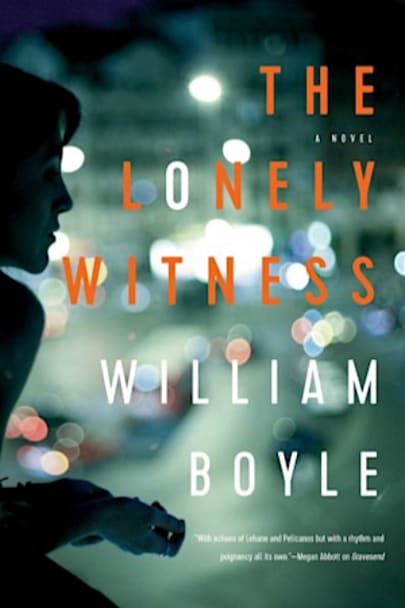Amy was once a party girl, but she now lives a lonely life, helping the house-bound to receive communion in the Gravesend neighborhood of Brooklyn. She stops in at one of the apartments on her route and Mrs. Epifanio says her usual caretaker, Diane, has the flu–or so Diane’s son Vincent says.Amy’s brief interaction with Vincent in the apartment that day sets off warning bells, so she assures … Mrs. E that she’ll find out what’s going on. She tails Vincent and a mysterious man through Brooklyn, but then, almost before Amy can register what has happened, Vincent is dead. And for reasons she can’t quite understand, Amy collects the murder weapon from the sidewalk and soon finds herself on the trail of a killer.
more



Summary:
Amy, a former wild girl, lives an isolated life as a Eucharistic Minister to elderly shut-ins in her Brooklyn parish. When one resident mentions that her normal caretaker, Diane, has sent her son to take her place for several days. Vincent, the son, gives the elderly woman the creeps. He claims Diane’s got the flu, but she doesn’t answer the phone when either Amy or the elderly woman call her number. Cue ominous drumroll. Does Diane really have the flu . . . or did Vincent kill his mother? Amy follows Vincent.
After Vincent leaves a local bar, he is joined by another man. Then the other man stabs Vincent to death. Amy, rather than report the murder, takes the knife and follows the man.
In the meantime, two people from her past show up: her ex-girlfriend Alessandra, who’s in town for a film audition, and Amy’s long-gone alcoholic father Fred, whom she’d written off as dead. Fred is now sober and wants to apologize to his only child; Amy, however, doesn’t want him in her life. She does want Alessandra.
As the aftermath of Vincent’s death grows increasingly complex, Amy must decide whether to tell what she knows or stay silent. She also finds herself at a personal crossroads: who is she? And is who she is now the same as who she wants to be in the future? Could finding this killer lead to her own redemption?
My thoughts
What worked for me:
1. Amy
She’s a flawed, interesting, and not quite sympathetic character. While she’s conflicted about her actions, but she gets a voyeuristic thrill from them. It’s a bit of excitement in her dull life. Trying to “help a little” as a Eucharistic Minister to elderly shut-ins isn’t as rousing as her previous crowd. She’s gay, though she never bothers to explain this to the elderly people trying to set her up with their grandsons/nephews/neighbors/random single males in their lives.
Early in the book, Amy recounts witnessing a murder. (This happens on page 10, so it’s not a spoiler.) As a young teen, she watched through a window as her next-door neighbor strangled a man. She never spoke up. When she begins following the killer, she never finds proof that a murder happened. She even looks forward to seeing the killer: it’s exciting when everything–her grandparents, school, church, life–is boring. If that doesn’t pique your interest in this character, I’m not certain what will.
2. The tone
Boyle constantly increases the creepiness level in the story. Just when I thought it couldn’t get any creepier, it did. Even reading the ending first didn’t lessen the tension and didn’t take away the chilling, ominous feeling covering me while I read.
3. The setting
I was impressed by how well Boyle used the Brooklyn setting. With it, he creates a mood of despair and brokenness, of thwarted dreams and a dying, forgotten place filled with forgotten people. It’s the former home of Amy’s ex-girlfriend, who was desperate to leave and when she returns, feels trapped in it again. Yet Amy chooses to move here.
4. The Catholicism/saints motifs
(Remember, I have a degree in English, so I geek out about literary symbolism.)
Boyle does a great job with this one. From St. Therese, who inspires Amy to “help a little”, to the priest’s admonitions to give her father a second chance, to the St. Joan medal she filches, intending to give it to her ex-girlfriend: it works to add depth and dimension to the characters and the story.
5. The ending
(No spoilers!) It might not be the ending that I want, but it works. Amy has grown as a character. The loose threads are mostly tied and clipped. The other characters are accounted for. It’s a satisfying ending.
What didn’t work for me:
I can’t think of anything. I truly enjoyed this book!
That’s interesting to me, as I usually dislike noir as a subgenre. It’s too cynical. The protagonists remind me too much of myself on a bad mental health binge, making all the wrong choices in life. (Don’t ask.) Watching people screw up their lives is too darned depressing. Whenever I read a novel in this subgenre, I feel like the author and I are pitted against each other: will the strength of the story win, or will the book only confirm my prejudice against the genre? I typically give up after a few chapters.
So, Meredith, you ask, why’d you read this book?
The cover. It hit all the right notes for me, and that was enough to entice me to open the cover and read the story.
Despite the distinctly noir tone of the novel, despite the cynicism and fatality of Amy’s views, despite all that, Boyle won: I flew through this story. I grew to care about Amy, even when she was at her most self-destructive. Bravo, Mr. Boyle.
Overall, this is an impressive book.